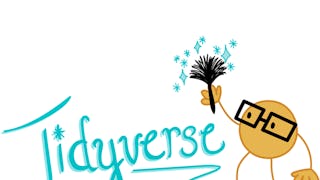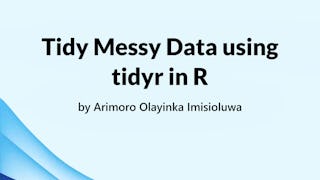This course aims to better develop your statistical toolkit in the world of statistics and data science. You will learn how to collect, manipulate, and transform data in R into a more readily usable format using tidyverse data pipelines, primarily using verbs from the dplyr and tidyr packages. The topics covered provide you with the tools necessary to convert data to be better suited for data visualization (Course 1) and modeling; which is to come in this certificate program in a future course. Additionally, we discuss the topics of web scraping and the considerations one must take prior to scraping data from the web.



Data Tidying and Importing with R
This course is part of Data Science with R Specialization


Instructors: Dr. Elijah Meyer
Included with 
What you'll learn
Apply tidy data principles to manipulate and restructure data (e.g., subsetting, adding columns, and transforming data between wide and long formats)
Develop and implement code to join data sets and perform basic web scraping to collect data
Apply data structures such as wide and long formats, using code to convert between these formats as part of data preparation and analysis
Skills you'll gain
Details to know

Add to your LinkedIn profile
3 assignments
See how employees at top companies are mastering in-demand skills

Build your subject-matter expertise
- Learn new concepts from industry experts
- Gain a foundational understanding of a subject or tool
- Develop job-relevant skills with hands-on projects
- Earn a shareable career certificate


Earn a career certificate
Add this credential to your LinkedIn profile, resume, or CV
Share it on social media and in your performance review

There are 3 modules in this course
Tidy datasets have a specific structure: each variable is a column, and each observation is a row. In this module, we use functional verbs from the dplyr package in R to transform data into a ready-to-use tidy data format. Additionally, we use functional verbs to manipulate data frames.
What's included
6 videos12 readings1 assignment2 discussion prompts1 plugin
A column in our data set can be stored as many different types, such as numbers or characters. These different data types inform how R treats the data, and whether certain functions are compatible to use with certain types of data. In this module, we discuss more in detail, the different data types classified by R, data classes, as well as how to recode variables in a data set to be different types, classes, or take on different values.
What's included
6 videos13 readings1 assignment1 discussion prompt1 plugin
Web scraping is the process of extracting this information automatically and transforming it into a structured dataset. In this module, we go over how to perform basic web scraping in R to make an abundance of data online more easily accessible.
What's included
4 videos5 readings1 assignment2 discussion prompts1 plugin
Instructors

Offered by
Explore more from Data Analysis


Johns Hopkins University


Coursera Project Network


Johns Hopkins University


Coursera Project Network
Why people choose Coursera for their career




New to Data Analysis? Start here.

Open new doors with Coursera Plus
Unlimited access to 10,000+ world-class courses, hands-on projects, and job-ready certificate programs - all included in your subscription
Advance your career with an online degree
Earn a degree from world-class universities - 100% online
Join over 3,400 global companies that choose Coursera for Business
Upskill your employees to excel in the digital economy
Frequently asked questions
Access to lectures and assignments depends on your type of enrollment. If you take a course in audit mode, you will be able to see most course materials for free. To access graded assignments and to earn a Certificate, you will need to purchase the Certificate experience, during or after your audit. If you don't see the audit option:
The course may not offer an audit option. You can try a Free Trial instead, or apply for Financial Aid.
The course may offer 'Full Course, No Certificate' instead. This option lets you see all course materials, submit required assessments, and get a final grade. This also means that you will not be able to purchase a Certificate experience.
When you enroll in the course, you get access to all of the courses in the Specialization, and you earn a certificate when you complete the work. Your electronic Certificate will be added to your Accomplishments page - from there, you can print your Certificate or add it to your LinkedIn profile. If you only want to read and view the course content, you can audit the course for free.
If you subscribed, you get a 7-day free trial during which you can cancel at no penalty. After that, we don’t give refunds, but you can cancel your subscription at any time. See our full refund policy.
More questions
Financial aid available,

